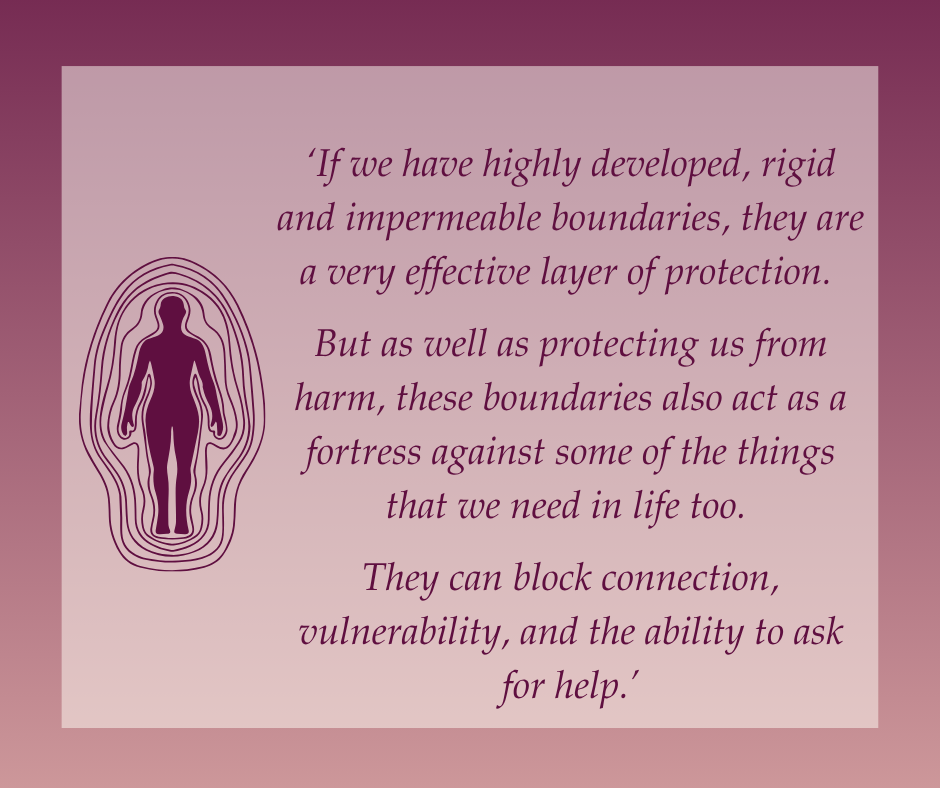We talk a lot about boundaries — but what if they’re the problem instead of the solution?
- Georgina Sturmer

- Aug 7
- 4 min read
Boundaries often play a central role in therapy. But as we talk more about boundaries, it can start to feel like they're always a good thing. And that strengthening our boundaries is always going to make us feel more confident and resilient. But the truth is that it's a little more complicated than that. In this post, I'll explore what boundaries are, where our boundaries come from, why we don't always want to make them stronger, and - if this resonates with you - how to change your approach to boundaries so that you can feel more connected and less alone in your relationships.
So what are boundaries?
I like to think of boundaries as an invisible force field. A layer that protects us from being influenced, overwhelmed, or taken over by those around us. They give us a sense of who we are and how we can stay in control of our life.
These boundaries factor into our lives in two ways:
External boundaries relate to how we speak to other people, how we approach things like tasks at work and timekeeping.
Internal boundaries relate to how we protect ourselves from other people's opinions and judgements
Just like in the tale of Goldilocks, sometimes our boundaries are too thick, or too thin - rather than being 'just right'. Broadly speaking, our boundaries can take three forms:
Rigid and tough - like a dense layer of protection
Flexible and secure - protective but adaptable and open
Thin and porous - where everything can seem to seep through
Where do our boundaries come from?
From the moment we are born, we start trying to make sense of the world around us. This begins with understanding the separation between ourselves and our mother. And it continues as we learn what others want from us, and how we have to behave in our family to get our needs met.
If we are encouraged to be independent, then we are likely to develop stronger boundaries. This is often linked with an avoidant/dismissive attachment style.
If those around us are clingy or needy towards us, then we might develop weaker boundaries. This is often linked with an anxious/ambivalent/preoccupied attachment style.
And we are also likely to copy, or respond to, the patterns that we see in the relationships around us.
Note that we don't always have the same approach to boundaries as our siblings. Even though we have grown up in the same family, we never actually have exactly the 'same' upbringing or the 'same' parenting.
As we grow older, these boundaries can be reinforced - or challenged - by other relationships and responsibilities. We might find that we can be adaptable in certain circumstances, changing our style if we need to. But when we are under stress or pressure, that's when we will tend to revert to our 'default' boundary style.
How can boundaries become a problem?
As I've mentioned, we often focus on developing and strengthening boundaries in therapy. Learning how to put ourselves first, stop apologising and start saying 'no' when we need to. But it's not a one-size-fits-all solution. In fact, some of us sit at the other end of the spectrum. If we have highly developed, rigid and impermeable boundaries, they are a very effective layer of protection. But as well as protecting us from harm, these boundaries also act as a fortress against some of the things that we need in life too. They can block connection, vulnerability, and the ability to ask for help.

How do you know if your boundaries are 'too' rigid?
You pride yourself on being independent, but you end up feeling lonely
When things are tough, you struggle to ask for help, or push it away when it's offered
You avoid talking about your feelings - or you might struggle to even identify your feelings - even with people you care about
You keep yourself on the outside in groups, or assume that other people won't like the 'real you'
Ok this sounds like me ... now what?
You might be reading this and thinking, 'that sounds like me - but why does it matter?'. And the answer is that when we behave in this way, it comes at a personal cost. Keeping ourselves on the outside might feel safe, but it can also be lonely and exhausting. It can mean that we struggle to build the deep connections that we all instinctively crave.
The good news is that change is always possible. It starts with noticing what our boundaries are like. Figuring out if our independence and self-reliance is simply a cover for emotional avoidance and a fear of closeness. And it's that fear of closeness that we can really explore in therapy. Where it comes from, and what it might feel like to challenge ourselves, to be vulnerable, and to try behaving differently in our relationships.
If this resonates with you, therapy can offer a safe space to explore your boundaries, understand where they come from, and gently try out new ways of connection. Click here to contact me, or click here to book a 30-minute introductory call.




Comments